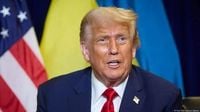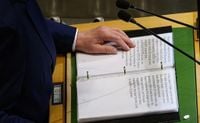President Donald Trump’s address to the 80th session of the United Nations General Assembly on September 23, 2025, was nothing short of a spectacle. Standing before world leaders at U.N. headquarters, Trump delivered a speech that blended campaign bravado with sweeping claims about his record—some of which have been repeatedly challenged by experts and contradicted by hard data. The president’s most striking assertion? That, in just seven months, he had ended seven wars—conflicts he described as “unendable.”
“In a period of just seven months, I have ended seven unendable wars. They said they were unendable,” Trump declared, repeating a line that has become a staple of his second-term narrative, according to the Associated Press. The claim, while headline-grabbing, has been met with skepticism and, in many cases, outright refutation from foreign policy analysts, diplomats, and even some of the countries involved.
Let’s take a closer look at the substance behind Trump’s bold pronouncement—and the broader context of his U.N. speech, which, as TIME noted, was replete with “provable facts wrong.”
Israel and Iran: A Temporary Respite
Trump’s most credible claim comes from the 12-day war between Israel and Iran in June 2025. After Israeli strikes on Iranian nuclear facilities, the region teetered on the edge of a wider conflict. Trump intervened by directing American warplanes to target Iran’s Fordo, Isfahan, and Natanz nuclear sites, which ultimately led to a ceasefire. Evelyn Farkas, executive director of Arizona State University’s McCain Institute, told the Associated Press, “There’s always a chance it could flare up again if Iran restarts its nuclear weapons program, but nonetheless, they were engaged in a hot war with one another. And it didn’t have any real end in sight before President Trump got involved and gave them an ultimatum.”
Still, Lawrence Haas of the American Foreign Policy Council characterized the outcome as a “temporary respite” rather than a true end to hostilities, noting that the underlying “cold war” between the two nations persists.
Egypt, Ethiopia, and Sudan: Tensions Remain
Trump also cited the conflict over the Grand Ethiopian Renaissance Dam as one of the wars he ended. Yet, as Haas pointed out, “It would be a gross overstatement to say that these countries are at war. I mean, they’re just not.” Ethiopia completed the dam in July and inaugurated it in September, but the dispute with Egypt and Sudan over water rights and flooding risks remains unresolved. Trump had previously attempted to broker a deal, even suspending aid to Ethiopia at one point, but negotiations have since stalled. No peace agreement has been reached, and tensions linger.
India and Pakistan: U.S. Role Disputed
The April 2025 killing of tourists in Indian-controlled Kashmir brought India and Pakistan dangerously close to war, but a ceasefire was achieved. Trump has claimed credit for brokering the truce, citing U.S. trade concessions as part of the deal. Pakistan even recommended him for the Nobel Peace Prize. However, India has denied any U.S. involvement in trade-related talks. Farkas acknowledged that “President Trump played a constructive role from all accounts, but it may not have been decisive. And again, I’m not sure whether you would define that as a full-blown war.”
Serbia and Kosovo: The Status Quo
Trump’s list of seven wars also includes Serbia and Kosovo, two neighbors with a long history of tension. However, there has been no imminent threat of war between them during Trump’s second term. While Trump did help broker a deal in his first term, much of it was never implemented, and NATO-led peacekeepers continue to maintain stability in the region.
Rwanda and the Democratic Republic of the Congo: A Partial Peace
In June 2025, Trump facilitated a peace deal between the foreign ministers of Rwanda and the Democratic Republic of the Congo at the White House. The agreement aimed to ease hostilities in eastern Congo, where the M23 rebel group—backed by Rwanda—remains a potent force. Yet, as AP noted, the M23 was not part of the negotiations and has not agreed to the terms. A separate, Qatar-facilitated deal was supposed to bring about a permanent ceasefire, but there have been no public signs of progress.
Armenia and Azerbaijan: A Step Forward, Not a Finish Line
Trump’s efforts to resolve the decades-long conflict between Armenia and Azerbaijan culminated in an August 2025 meeting at the White House, where both leaders initialed a treaty aimed at normalizing ties. Armenian Prime Minister Nikol Pashinyan called the document a “significant milestone,” and Azerbaijani President Ilham Aliyev praised Trump for performing “a miracle.” However, the treaty has yet to be signed and ratified, leaving the peace process unfinished.
Cambodia and Thailand: Ceasefire Brokered
After a border clash in May and July 2025, Cambodia and Thailand agreed to an unconditional ceasefire in late July, following Trump’s intervention. The U.S. president pressured both countries by warning that trade agreements would be off the table if hostilities continued. Ken Lohatepanont, a political analyst, told the AP, “President Trump’s decision to condition a successful conclusion to these talks on a ceasefire likely played a significant role in ensuring that both sides came to the negotiating table when they did.”
Beyond the Wars: Fact-Checking Trump’s U.N. Claims
Trump’s U.N. speech was not limited to foreign policy boasts. He claimed, for example, that “inflation has been defeated,” that “grocery prices are down,” and that “our [electricity] bills are coming way down.” According to TIME, none of these statements hold up to scrutiny. Inflation stood at 2.9% in August 2025 compared to a year earlier, grocery prices were up 2.7%, and electricity prices had jumped 6.2%. Since Trump took office in January, inflation has held steady, groceries are up 1%, and electricity is up 4.9%—hardly the dramatic improvements he described.
He also repeated claims of having the highest poll numbers ever, though public polling shows his approval rating dropped from 47% in January to 40% in September. Satisfaction with the nation’s direction has fallen from 34% to 29% over the same period, with much of the decline attributed to waning Republican support, according to Gallup data cited by TIME.
Trump further asserted that $17 trillion in foreign investments had flowed into the U.S.—a figure that nearly doubles a previous White House claim of $9 trillion, which itself was considered suspect. He also repeated the line about signing the largest tax cut in history and made false statements about migrant children under the Biden administration, both of which have been widely debunked.
The Politics of Truth
Trump’s penchant for hyperbole and, at times, outright fabrication is not new, but the reaction to his U.N. speech has revealed a growing numbness among both the public and the press. As TIME’s D.C. Brief observed, “All politicians have elastic relationships with absolute truths. Neither party escapes the occasional smudge, here a rounding there.” Yet, Trump’s approach—what journalist Ryan Lizza has described as “sanewashing”—pushes the boundaries of political spin into a realm where facts often take a back seat to narrative and spectacle.
There was a time, as the piece notes, when a single gaffe could derail a campaign. Mitt Romney’s infamous “47%” comment in 2012, while factually accurate in part, was enough to shift the race by several points. Today, Trump’s factual inaccuracies on a global stage seem to prompt little more than a collective shrug.
The world watched as Trump painted a picture of triumph and resolution, but beneath the surface, the reality is far more complex. Wars may pause, but peace is rarely so tidy—and the facts, however inconvenient, still matter.


